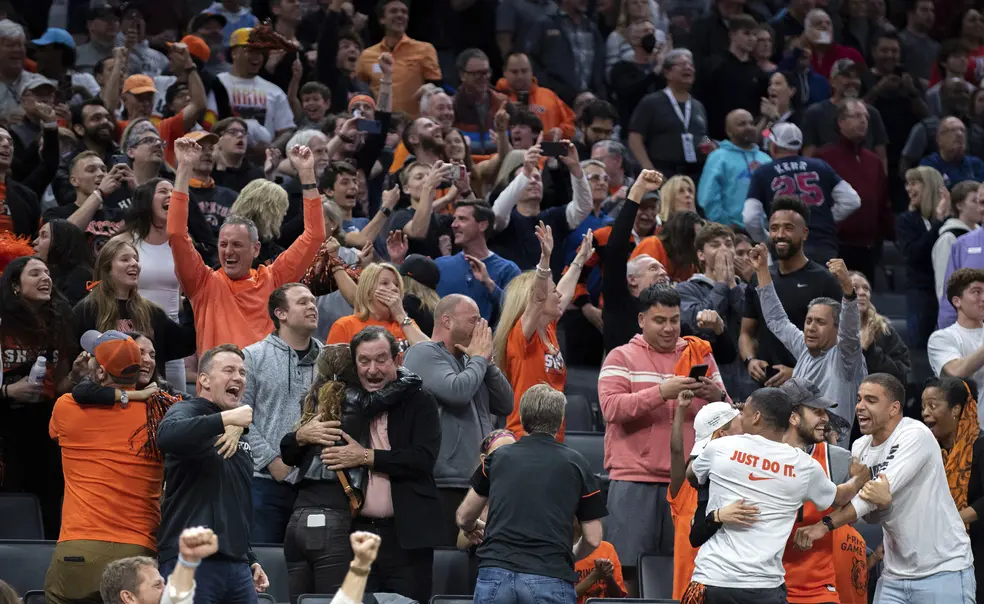1996 Tigers Like Princeton Men’s Chances Against Missouri
Members of the team that upset UCLA under Pete Carril explain why this year’s team can advance to the Sweet 16
A fresh canvas awaits the Princeton men’s basketball team on Saturday (6:10 p.m. ET) in Sacramento, California, another 40-minute chance to paint a reason for revelry. Forty-eight hours after shocking No. 2 Arizona, No. 15 Princeton goes against seventh-seeded Missouri in the second round of the men’s NCAA Tournament, and one of the key contributors to the fabled 1996 Tiger team likes his alma mater’s chances.
The victory over Arizona, after all, wasn’t the product of eat-the-clock gimmickry, and certainly not of unsustainable, lights-out shooting; Princeton was 4-for-25 from three-point range. It was, rather, an outcome built on stoutness, resolve and a boxing-out masterclass.
“Princeton is legit on defense,” says Brian Earl ’99, a reserve guard who helped the Tigers famously take down defending-champion UCLA in the 1996 NCAA Tournament, and now the coach of Cornell. “I think that’s what turned it their way. They make everything hard offensively. It’s hard to root for Princeton coming from Cornell, but that [connection] is always going to be there.”
Earl, who would go on to be Ivy League player of the year as a senior in 1999, shared a backcourt with current Princeton coach, Mitch Henderson ’98. Earl sees parallels in the iconic victory over UCLA — the final victory in the Hall-of-Fame career of coach Pete Carril — and Thursday’s triumph over Arizona. Both opponents were athletically gifted, West Coast teams that seemed destined to overwhelm the Tigers with their weapons and up-tempo style.
“You watched and watched and waited for the Pac-12 teams to pull away, and it never happened,” Earl says. “When you have teams like UCLA and Arizona that like to play fast and get easy buckets and it doesn’t go that way, you see a little bit of panic set in.”
Sydney Johnson ’97, the captain of the 1996 Princeton team, took in the first round at his home in Connecticut.
“It was a classic David and Goliath story, right?” Johnson said. “Arizona is an awesome team that had a great season, one of the powers of college basketball. And then you have the Princeton Tigers, who needed to give everything they could muster to beat Yale just to get into the tournament. It was just a magical outcome. And it makes me feel really attached to these young men, who are going to have a memory for a lifetime.”
In Princeton’s other signature tournament triumph, the Tigers dumped UNLV in the first round of the 1998 NCAA Tournament. Earl had 21 points in that game, Henderson 19. Johnson, who had graduated and was playing pro ball in Europe, said such outcomes were not remotely a fluke, beginning with “the DNA” instilled by Carril, who died last August and whose memory is honored by a patch on Princeton’s uniforms.
“We’re not Kentucky,” Johnson said. “We’re not North Carolina. We’re not Kansas. But Pete Carril taught us a whole lot about basketball — about team play, about unselfishness, about sacrifice and being smart and paying attention to detail. That how’s we were molded. That’s what was hammered into us, and that’s the kind of DNA that helps you in big games. We were built for it because of what Pete Carril instilled in us, and I’m proud that Mitch Henderson has passed that on to his players.”
Earl and Johnson said that it was a smart, thoroughly detailed scouting report that was responsible for the winning play against UCLA in the 1996 tourney. Studying UCLA on film, Princeton’s staff noticed that Bruin defenders had a propensity to relax after covering the first back-door cuts in motion offenses. With seconds ticking down on Princeton’s final possession, center Steve Goodrich ’98 had the ball to the right of the lane when forward Gabe Lewullis ’99 started his backdoor cut. Goodrich faked a pass. Lewullis stopped and retreated a step. Charles O’Bannon, guarding Lewullis, stood up and relaxed a bit, and then Lewullis went again, Goodrich hitting him with a perfect bounce pass, and Lewullis, now an orthopedic surgeon in his hometown of Allentown, Pennsylvania, banking it in under heavy pressure. The final score was Princeton 43, UCLA 41.
“We practiced those layups — going full-speed, under pressure — all the time, every day,” Johnson said. “We did them by the hundreds.”
The ’96 Tigers run ended abruptly in the second round, when they were dominated by Final Four-bound Mississippi State, a team led by star center Erick Dampier, who would play 17 years in the NBA.
“I remember they had guards who were like 6-3, 220, and I was 6-1, 150,” Earl said, laughing. “It wasn’t a question of [not being ready to play after the UCLA game]. They were awesome.”
Johnson, for his part, doesn’t think Missouri will be surprised by Princeton, after its performance against Arizona, but says he still believes that orange-and-black DNA may come into play again if the game is close late. Earl doesn’t pretend to know how the canvas will turn out, but he does know about the makeup of the program he once starred for.
“They are a pretty workmanlike team,” Earl said. “There’s not lot of emotional, up-and-down energy. It might benefit them going into this game. They may think, ‘We won a game against Arizona, and now we have a Missouri team that plays the same way. All we have to do is do our job.’ ”












No responses yet